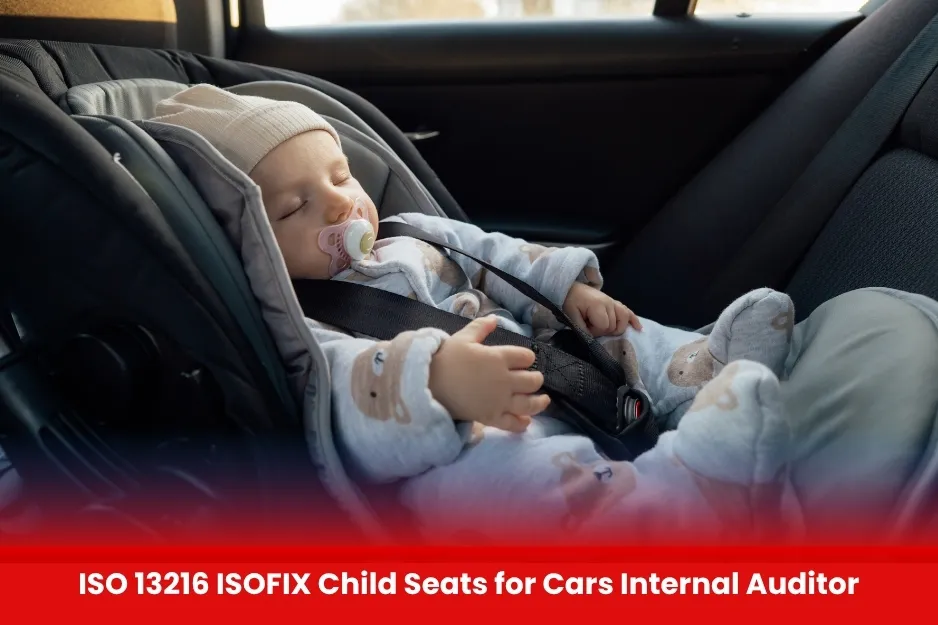ISO 13216 ISOFIX Child Seats for Cars Internal Auditor
The aim of the internal audit is to systematically evaluate and verify that the design, manufacturing, testing, and installation processes of ISOFIX child restraint anchorage systems comply with the requirements of ISO 13216, relevant automotive safety regulations, and the organization’s quality management system. This ensures the production of safe, reliable, and compliant child restraint systems that provide maximum protection to child passengers.

Aim of ISO 13216 ISOFIX Child Seats for Cars Internal Auditor
The aim of the internal audit is to systematically evaluate and verify that the design, manufacturing, testing, and installation processes of ISOFIX child restraint anchorage systems comply with the requirements of ISO 13216, relevant automotive safety regulations, and the organization’s quality management system. This ensures the production of safe, reliable, and compliant child restraint systems that provide maximum protection to child passengers.
Course Overview
ISO 13216 ISOFIX Child Seats for Cars Internal Auditor
Educational Background
- Minimum: High school diploma or equivalent.
- Preferred: Degree or diploma in mechanical engineering, automotive engineering, quality management, or a related technical field.
Knowledge of ISO 13216 Standard
- Understanding of ISO 13216 requirements related to ISOFIX anchorage systems (parts 1 and 2).
- Familiarity with associated automotive regulations (e.g., UN ECE R14, R44, R129).
Auditing Skills and Training
- Completion of an Internal Auditor Training Course, preferably including training on ISO 13216 or automotive safety standards.
- Knowledge of general auditing principles (ISO 19011).
| Course Code | Curriculum Title | Credit | DLH |
|---|---|---|---|
| BUK1949-1 | Introduction to ISO 13216 and ISOFIX Systems | 2 | 15 |
| BUK1949-2 | Design and Technical Requirements | 2 | 15 |
| BUK1949-3 | Manufacturing & Process Controls | 2 | 15 |
| BUK1949-4 | Testing and Compliance Requirements | 2 | 15 |
| BUK1949-5 | Conducting the Audit | 2 | 15 |
| BUK1949-6 | Introduction to Internal Auditing (ISO 19011) | 2 | 15 |
| BUK1949-7 | Conducting an ISO 13216 Internal Audit | 2 | 15 |
| BUK1949-8 | Reporting and Corrective Actions | 2 | 15 |
Module 1: Introduction to ISO 13216 and ISOFIX Systems
- Overview of ISO 13216-1 and ISO 13216-2
- Purpose and benefits of ISOFIX systems
- Types of child restraint systems (CRS)
- Components of ISOFIX: Lower anchorages and top tether
- Global regulations overview (e.g., UN ECE R14, R16, R129)
Module 2: Design and Technical Requirements
- ISOFIX anchorage positioning and dimensions
- Design validation and integration in vehicle structure
- Load path analysis
- Interpretation of technical drawings
- Material selection and corrosion resistance considerations
Module 3: Manufacturing & Process Controls
- Key manufacturing processes: welding, assembly, fastening
- In-process controls and inspections
- Control of critical dimensions and tolerances
- Supplier quality management for ISOFIX components
Module 4: Testing and Compliance Requirements
- Static and dynamic load testing of ISOFIX anchorages
- Test methods per ISO 13216 and UN regulations (ECE R14, R129)
- Destructive and non-destructive testing
- Reporting and documentation of test results
Module 5: Introduction to Internal Auditing (ISO 19011)
- Audit principles, ethics, and auditor responsibilities
- Types of audits: system, process, and product
- Audit life cycle: planning, conducting, reporting, follow-up
- Risk-based thinking in audit planning
Module 6: Conducting an ISO 13216 Internal Audit
- Preparing audit checklists specific to ISOFIX
- Identifying and collecting objective evidence
- Interview techniques and observation skills
- Document review (drawings, control plans, test reports)
Module 7: Reporting and Corrective Actions
- Writing clear and factual audit reports
- Identifying nonconformities vs observations
- Root cause analysis (RCA) basics
- Corrective and preventive action tracking (CAPA)
Module 8: Integration with Quality Management Systems
- Link between ISO 13216 and ISO 9001 / IATF 16949
- Process audits within QMS context
- Customer-specific requirements (e.g., OEM audit standards)
- Traceability and change management
- Quality Assurance / Quality Control Professionals
- Design & Development Engineers
- Production / Manufacturing Engineers
- Internal Auditors (Existing or New)
- Supplier Quality Engineers / Supplier Auditors
- Testing and Validation Engineers
- All Modules within this qualification are assessed internally by the approved training Centre and externally verified by BURRAQ UK. The program uses a criterion-referenced assessment approach to ensure that learners successfully meet all required learning outcomes.
- A Pass in any unit is granted only when the learner submits valid, reliable, and authentic evidence that demonstrates achievement of the assessment criteria. The Assessor is responsible for reviewing this evidence and confirming that the learner has attained the expected standard.
